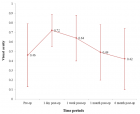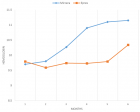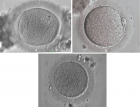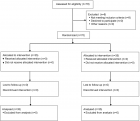Abstract
Research Article
Evaluation of endothelial function in obese children and adolescents
Hacer Efnan Melek, Ayça Törel Ergür* and Gökçe Kaan Ataç
Published: 01 March, 2021 | Volume 5 - Issue 1 | Pages: 014-023
Introduction: Obesity defined as increased fatty mass is progressively rising in recently, even though its affects begins to all systems in childhood and adolescence periods, the most important morbidity and mortality reason of obesity is its effects on the cardiovascular system. Researches point out endothelial dysfunction and atherosclerosis as the reason of the cardiovascular system disease in obesity. The studies conducted on childhood period related to this subject are highly limited and the results of these are also controversial. Therefore in our study the effects of obesity on endothelial functions in children and adolescents was assessed by flow mediated dilation (FMD) method. In addition to that, effects of epidemiological, biochemical, hormonal and clinical features of cases to FMD were investigated.
Material and method: A total number of 104 cases were cover in this study. Obese group (group 1) was consisted of 59 children whose body mass index (BMI) was ≥ 95th percentile and mean age was 12 ± 2.8 years old. The control group (group 2) consisted of 45 children whose body mass index (BMI) was between 25th -84th percentil and mean age was 11.4 ± 2.9 years old. The detailed history, epidemiological data and physical examination were performed. The population classified three groups according to sport activities. 97th percentile and higher values were accepted as morbid obesity. The blood pressure was measured with a mercury sphygmomanometer with utilizing the proper size cuff in compliance with the criterion used by the “National High Blood Pressure Education Program Working Group”. The complete blood count and biochemistry tests (renal and liver function tests, electrolytes, lipids, hsCRP) of the cases were analysed with biochemistry Roche Cobas Integra 800 and hormon assays of the cases (thyroid function tests, diurnal cortisol, ACTH, 17 OHP, prolactin, DHEA-S) were analysed by ECLIA method on Roche Elecsys 2010 device in the laboratory of our hospital. IR-HOMA values > 2.5 in prepuberal and > 4 in pubertal were defined as the insulin resistance. Bone ages of cases were evaluated with left hand wrist X-ray by using Greulich and Pyle Bone Age Atlas. flow mediated dilation (FMD) was used to assess the endothelial functions of all cases. The brachial artery was evaluated with SPG 12 MHz surface probes by using GE voluson ultrasound system in this method. FMD was expresses as percent (%) increase according to the basal vein dimension. 7% mean value was taken as the limit in the comparisons.
Results: The ratio of male and female was 20/39 in group 1 and 14/31 in group 2. 32.3% of the cases in group 1 and 47.6% of the cases in group 2 were prepubertal. The waist and hip circumferences ratio of the group 1 (0.86 ± 0.05) was significantly higher than group 2 (0.80 ± 0.07). While there was no difference between groups 1 and 2 in terms of the birth weight, using duration period of vitamin D and beginning time to additional nutrition, breastfeeding duration of group 1 (10.6 ± 7.8 months) was significantly shorter than group 2 (14 ± 7.4 months). BMIs of the mothers in group 1 were statistically higher than the mothers in group 2 (27.5 ± 4.8 kg/m² and 24.3 ± 3.2 kg/m² respectively. The mean of IR-HOMA was 4 ± 2.9 in group 1 and 1.9 ± 0.8 in group 2 and there was the insulin resistance in 51% of the obese cases. The dyslipidemia was diagnosed in 38.5% of the cases in group 1. The systolic and diastolic blood pressures in group 1 (117 ± 12.2 mmHg and 73.7 ± 9.4 mmHg respectively) were significantly higher than in group 2 (107.5 ± 9.1 mmHg and 68.2 ± 7.1 mmHg respectively). Hypertension was determined in 25% of the cases included in group 1. The minimum values of FMD in groups 1 and 2 were 1.01% and 3.1% respectively. The maximum values of FMD in groups 1 and 2 were 9.7% and 15% respectively. The mean values of FMD was %5 ± 2.3 in group 1 and %8.1 ± 3.5 in group 2. Compared with group 2, group 1 demonstrated significantly impaired FMD. There was no association between FMD and the birth weight, breastfeeding duration, physical exercises in two groups. A negative correlation was found between FMD and BMI (p < 0.01, r = -0.402). The correlation was determined between FMD and BMI of the mother (p = 0.017, r = -0.305) and the presence of obese individuals in the family (p = 0.021, r =-0.413). It was found that a significant negative correlation between FMD and waist-hip circumference ratio (p = 0.003, r = -0.421). When each groups were assessed in terms of biochemical and hormonal characteristics, there was low negative correlation between FMD and uric acid level and strong negative correlation between FMD and ALT level were determined in group 1.
Conclusion: In our study showed that the obesity begins in the childhood period may cause to the endothelial dysfunction. For this reason, according to our opinion, recognition prior indicators of endothelial dysfunction in early time may be helpful both to take the precautions required and to prevent cardiovascular complications in childhood and influences to the adult period.
The rising sizes of the waist and hip circumferences, positive family history for obesity and obesity of the parents were determined as the most important parameters negative affecting FMD. Unlike the literature, the association between endothelial dysfunction and GGT level the indicator of the hepatosteatosis in obese children was also found as well as FMD and ALT have also a close association independent from BMI in this study. Thus, a different point of view was formed since ALT may possibly have a predictor value in the assessment of the endothelial functions and it is also found as a highlighted risk factors for the endothelial dysfunction in this study. Because of this reason, it can be recommended that when the liver function tests carry out in obese children it does not show only hepatosteatosis but also can be used as an early indicator of the cardiovascular complications of obesity. Another important subject to be emphasize that the ALT level in the childhood period may be an early cardiovascular risk indicator in both obese and nonobese children.
Read Full Article HTML DOI: 10.29328/journal.acem.1001019 Cite this Article Read Full Article PDF
Keywords:
Childhood and adolescent obesity; Endothelial dysfunction
References
- Freedman DS, Dietz WH, Tang R, Mensah GA, Bond MG, et al. The relation of obesity throughout life to carotid intima-media thickness in adulthood: the Bogalusa Heart Study. Int J Obes Relat Metab Disord. 2004; 28: 159-166. PubMed: https://pubmed.ncbi.nlm.nih.gov/14581934/
- Skilton MR, Celermajer DS. Endothelial dysfunction and arterial abnormalities in childhood obesity. Int J Obes. 2006; 30: 1041-1049. PubMed: https://pubmed.ncbi.nlm.nih.gov/16801941/
- Ja¨rvisalo MJ, Ro¨nnemaa T, Volanen I, Kaitosaari T, Kallio K, et al. Brachial artery dilatation responses in healthy children and adolescents. Am J Physiol Heart Circ Physiol. 2002; 282: 87–92. PubMed: https://pubmed.ncbi.nlm.nih.gov/11748051/
- Zhu W, Huang X, Li M, Neubauer N. Arterial intima-media thickening and endothelial dysfunction in obese Chinese children. Eur J Pediatr. 2005; 164: 337–344. PubMed: https://pubmed.ncbi.nlm.nih.gov/15750804/
- Li AM, Celermajer DS, Chan MH, Sung RY, Woo KS. Reference range for brachial artery flow-mediated dilation in healthy Chinese children and adolescents. Hong Kong Med J. 2018; 24: 36-38. PubMed: https://pubmed.ncbi.nlm.nih.gov/29937445/
- Bots M, Westerink J, Rabelink TJ, de Koning KJP. Assessment of flow-mediated vasodilatation (FMD) of the brachial artery: Effects of technical aspects of the FMD measurement on the FMD response. Eur Heart J. 2005; 26: 363–368. PubMed: https://pubmed.ncbi.nlm.nih.gov/15618057/
- Deng YB, Li TL, Xiang HJ, Chang Q, Li CL. Impaired endothelial function in the brachial artery after Kawasaki disease and the effects of intravenous administration of vitamin C. Pediatr Infect Dis J. 2003; 22: 34–39. PubMed: https://pubmed.ncbi.nlm.nih.gov/12544406/
- Bonnet D, Aggoun Y, Szezepanski I, Bellal N, Blanche S. Arterial stiffness and endothelial dysfunction in HIV-infected children. AIDS. 2004; 18: 1037–1041. PubMed: https://pubmed.ncbi.nlm.nih.gov/15096807/
- Woo KS, Chook P, Chan WB, So WY, Cockram CS, Celermajer DS. Type 1 diabetes and arterial dysfunction in asymptomatic Chinese adults. Diabetes Care. 2001; 24: 173. PubMed: https://pubmed.ncbi.nlm.nih.gov/11194226/
- Kari JA, Donald AE, Vallance DT, Bruckdorfer KR. Physiology and biochemistry of endothelial function in children with chronic renal failure. Kidney Int. 1997; 52: 468–472.
- Lilien MR, Stroes ES, Op’t Roodt J, de Jongh S, Schro¨der CH, et al. Vascular function in children after renal transplantation. Am J Kidney Dis. 2003; 41: 684–691.
- Donaghue KC, Robinson J, McCredie R, Fung A, Silink M, et al. Large vessel dysfunction in diabetic adolescents and its relationship to small vessel complications. J Pediatr Endocrinol Metab. 1997; 10: 593–598. PubMed: https://pubmed.ncbi.nlm.nih.gov/9467129/
- Donaghue KC, Robinson J, McCredie R, Fung A, Silink M, et al. Macroangiopathy: does it play a role in young people? Horm Res. 1998; 50: 38–40. PubMed: https://pubmed.ncbi.nlm.nih.gov/9676996/
- Tounian P, Aggoun Y, Dubern B, et al. Presence of increased stiffness of the common carotid artery and endothelial dysfunction in severely obese children: a prospective study. Lancet. 2001; 358: 1400–1404. PubMed: https://pubmed.ncbi.nlm.nih.gov/11705484/
- Costa KCM, Ciampo LAD, Silva PS, Lima JC, Martins WP, Nogueira de Almeida CA. Ultrasonographic markers of cardiovascular disease risk in obese children. Rev Paul Pediatr. 2018; 36: 171-175. PubMed: https://pubmed.ncbi.nlm.nih.gov/29617475/
- Singhal A. Endothelial dysfunction: role in obesity-related disorders and the early origins of CVD. Proc Nutr Soc. 2005; 64: 15-22. PubMed: https://pubmed.ncbi.nlm.nih.gov/15877918/
- Franco MCP, Christofalo D, Sawaya A, Varille V, Guy-Grand B, et al. Effects of Low Birth Weight in 8- to 13-Year-Old Children: Implications in Endothelial Function and Uric Acid Levels. Hypertension. 2006; 48: 45-50. PubMed: https://pubmed.ncbi.nlm.nih.gov/16682609/
- Martin H, Hu J, Gennser G, Norman M. Impaired endothelial function and increased carotid stiffness in 9-year-old children with low birthweight. Circulation. 2000; 102: 2739–2744. PubMed: https://pubmed.ncbi.nlm.nih.gov/11094041/
- Leeson CP, Whincup PH, Cook DG, Donald AE, Papacosta O, et al. Flow-mediated dilation in 9- to 11-year-old children: the influence of intrauterine and childhood factors. Circulation. 1997; 96: 2233–2238. PubMed: https://pubmed.ncbi.nlm.nih.gov/9337195/
- Shirley DG, Walter SJ. Acute and chronic changes in renal function following unilateral nephrectomy. Kidney Int. 1991; 40: 62–68. PubMed: https://pubmed.ncbi.nlm.nih.gov/1921156/
- Khan F, Green FC, Forsyth JS, Greene SA, Newton DJ, et al. The beneficial effects of breastfeeding on microvascular function in 11- to 14-year-old children. Vasc Med. 2009; 14: 137-142. PubMed: https://pubmed.ncbi.nlm.nih.gov/19366820/
- Leeson CPM, Kattenhorn M, Deanfield JE, Lucas A. Duration of breast feeding and arterial distensibility in early adult life: population based study. Br Med J. 2001; 322: 643–647. PubMed: https://pubmed.ncbi.nlm.nih.gov/11250848/
- Forsyth JS, Willatts P, Agostoni C, Bissenden J, Casaer P, et al. Long chain polyunsaturated fatty acid supplementation in infant formula and blood pressure in later childhood: follow up of a randomised controlled trial. Br Med J. 2003; 326: 953–957. PubMed: https://pubmed.ncbi.nlm.nih.gov/12727766/
- Khan F, Elherik K, Bolton-Smith C, Barr R, Hill A, et al. The effects of dietary fatty acid supplementation on endothelial function and vascular tone in healthy subjects. Cardiovasc Res. 2003; 59: 955–962. PubMed: https://pubmed.ncbi.nlm.nih.gov/14553835/
- Garn SM, Sullivan TV, Hawthorne VM. Fatness and obesity of the parents of obese individuals. Am J Clin Nutr. 1989; 50: 1308-1313. PubMed: https://pubmed.ncbi.nlm.nih.gov/2596422/
- De Jongh S, Lilien MR, Bakker HD, Hutten BA, Kastelein JJ, et al. Family history of cardiovascular events and endothelial dysfunction in children with familial hypercholesterolemia. Atherosclerosis. 2002; 163: 193–197. PubMed: https://pubmed.ncbi.nlm.nih.gov/12048139/
- Gutin B, Islam S, Manos T, Cucuzzo N, Smith C, et al. Relation of percentage of body fat and maximal aerobic copacity to risk factors for atherosclerosis an diabetes in black and white seven-to eleven-year-old children. J Pediatrics.1994; 125: 847-852. PubMed: https://pubmed.ncbi.nlm.nih.gov/7996354/
- Wattigney W, Harsha DW, Srinivasan SR, Webber LS, Berenson GS. Increasing impact of obesity on serum lipids and lipoproteins in young adults. The Bogalusa Heart study. Arch Intern Med. 1991; 151: 2017-2022. PubMed: https://pubmed.ncbi.nlm.nih.gov/1929690/
- Cusi K, Maezono K, Osman A, Pendergrass M, Patti ME, et al. Insulin resistance differentially effects the PI3 kinase and MAPkinase-mediated signaling in human muscle. J Clin Invest. 2000; 105: 311-320. PubMed: https://pubmed.ncbi.nlm.nih.gov/10675357/
- Falcão-Pires I, Castro-Chaves P, Miranda-Silva D, Lourenço AP, Leite-Moreira AF. Physiological, pathological and potential therapeutic roles of adipokines. Drug Discov Today. 2012: 17: 880-899. PubMed: https://pubmed.ncbi.nlm.nih.gov/22561894/
- Steinberg HO, Chaker H, Leaming R, Johnson A, Brechtel G, et al. Obesity/insulin resistance is associated with endothelial dysfunction. J Clin Invest. 1996; 97: 2601–2610. PubMed: https://pubmed.ncbi.nlm.nih.gov/8647954/
- Chen NG, Homes M, Reaven GM. Relationship between insulin resistance, soluble adhesion molecules, and mononuclear cell binding in healthy volunteers. J Clin Endocrinol Metab. 1999; 84: 3485–3489. PubMed: https://pubmed.ncbi.nlm.nih.gov/10522984/
- Heinrich PC, Castell JV, Andus T. Interleukin-6 and the acute phase response. Biochem J. 1990; 265: 621–636. PubMed: https://pubmed.ncbi.nlm.nih.gov/1689567/
- Puddu P, Puddu GM, Cravero E, Vizioli L, Muscari A. The relationships among hyperuricemia, endothelial dysfunction, and cardiovascular diseases: molecular mechanisms and clinical implications. J Cardiol. 2012; 59: 235-242. PubMed: https://pubmed.ncbi.nlm.nih.gov/22398104/
- Khosla UM, Zharikov S, Finch JL, Nakagawa T, Roncal C, et al. Hyperuricemia induces endothelial dysfunction. Kidney Int. 2005; 67: 1739-1742. PubMed: https://pubmed.ncbi.nlm.nih.gov/15840020/
- Mercuro G, Vitale C, Cerquetani E, Zoncu S, Deidda M, et al. Effect of hyperuricemia upon endothelial function in patients at increased cardiovascular risk. Am J Cardiol. 2004; 94: 932–935. PubMed: https://pubmed.ncbi.nlm.nih.gov/15464681/
Figures:
Similar Articles
-
Evaluation of endothelial function in obese children and adolescentsHacer Efnan Melek,Ayça Törel Ergür*,Gökçe Kaan Ataç. Evaluation of endothelial function in obese children and adolescents. . 2021 doi: 10.29328/journal.acem.1001019; 5: 014-023
Recently Viewed
-
A Resurgence of the Idea of Hypertriglyceridemia and Lower Serum (HDL-C) as Predictive Factors for Insulin Resistance (IR) & Type 2 Diabetes Mellitus Development: A Narrative ReviewKulvinder Kochar Kaur*. A Resurgence of the Idea of Hypertriglyceridemia and Lower Serum (HDL-C) as Predictive Factors for Insulin Resistance (IR) & Type 2 Diabetes Mellitus Development: A Narrative Review. New Insights Obes Gene Beyond. 2025: doi: 10.29328/journal.niogb.1001022; 9: 001-012
-
Novel Mutation in Famous Gene Diseases in Red Blood CellsMahdi Nowroozi*. Novel Mutation in Famous Gene Diseases in Red Blood Cells. New Insights Obes Gene Beyond. 2025: doi: 10.29328/journal.niogb.1001023; 9: 013-020
-
Physical Performance in the Overweight/Obesity Children Evaluation and RehabilitationCristina Popescu, Mircea-Sebastian Șerbănescu, Gigi Calin*, Magdalena Rodica Trăistaru. Physical Performance in the Overweight/Obesity Children Evaluation and Rehabilitation. Ann Clin Endocrinol Metabol. 2024: doi: 10.29328/journal.acem.1001030; 8: 004-012
-
The Role of Genetic Mutations in the HPGD & SLCO2A1 Genes in Pachydermoperiostosis SyndromeShahin Asadi*,Arezo Zare,Sima Koohestani. The Role of Genetic Mutations in the HPGD & SLCO2A1 Genes in Pachydermoperiostosis Syndrome. J Genet Med Gene Ther. 2025: doi: 10.29328/journal.jgmgt.1001013; 8: 001-005
-
Estimation of Radiation Dose to Blood Vessels and Components from Medical Imaging Procedures: Current StatusKhalid M Aloufi*. Estimation of Radiation Dose to Blood Vessels and Components from Medical Imaging Procedures: Current Status. Arch Vas Med. 2025: doi: 10.29328/journal.avm.1001020; 9: 001-002
Most Viewed
-
Causal Link between Human Blood Metabolites and Asthma: An Investigation Using Mendelian RandomizationYong-Qing Zhu, Xiao-Yan Meng, Jing-Hua Yang*. Causal Link between Human Blood Metabolites and Asthma: An Investigation Using Mendelian Randomization. Arch Asthma Allergy Immunol. 2023 doi: 10.29328/journal.aaai.1001032; 7: 012-022
-
Impact of Latex Sensitization on Asthma and Rhinitis Progression: A Study at Abidjan-Cocody University Hospital - Côte d’Ivoire (Progression of Asthma and Rhinitis related to Latex Sensitization)Dasse Sery Romuald*, KL Siransy, N Koffi, RO Yeboah, EK Nguessan, HA Adou, VP Goran-Kouacou, AU Assi, JY Seri, S Moussa, D Oura, CL Memel, H Koya, E Atoukoula. Impact of Latex Sensitization on Asthma and Rhinitis Progression: A Study at Abidjan-Cocody University Hospital - Côte d’Ivoire (Progression of Asthma and Rhinitis related to Latex Sensitization). Arch Asthma Allergy Immunol. 2024 doi: 10.29328/journal.aaai.1001035; 8: 007-012
-
An algorithm to safely manage oral food challenge in an office-based setting for children with multiple food allergiesNathalie Cottel,Aïcha Dieme,Véronique Orcel,Yannick Chantran,Mélisande Bourgoin-Heck,Jocelyne Just. An algorithm to safely manage oral food challenge in an office-based setting for children with multiple food allergies. Arch Asthma Allergy Immunol. 2021 doi: 10.29328/journal.aaai.1001027; 5: 030-037
-
Snow white: an allergic girl?Oreste Vittore Brenna*. Snow white: an allergic girl?. Arch Asthma Allergy Immunol. 2022 doi: 10.29328/journal.aaai.1001029; 6: 001-002
-
Cytokine intoxication as a model of cell apoptosis and predict of schizophrenia - like affective disordersElena Viktorovna Drozdova*. Cytokine intoxication as a model of cell apoptosis and predict of schizophrenia - like affective disorders. Arch Asthma Allergy Immunol. 2021 doi: 10.29328/journal.aaai.1001028; 5: 038-040

If you are already a member of our network and need to keep track of any developments regarding a question you have already submitted, click "take me to my Query."


















































































































































